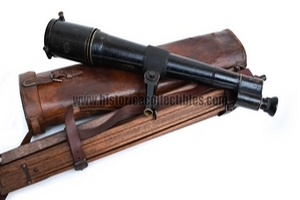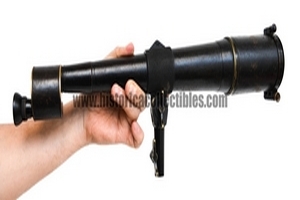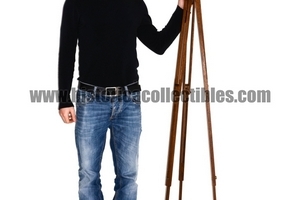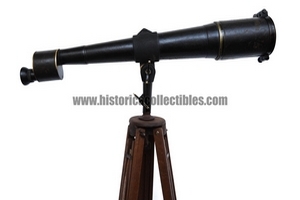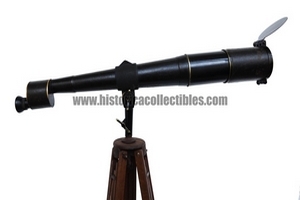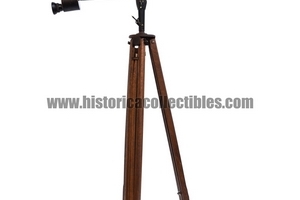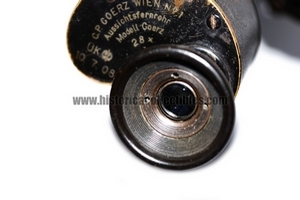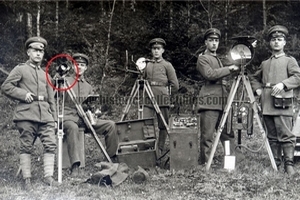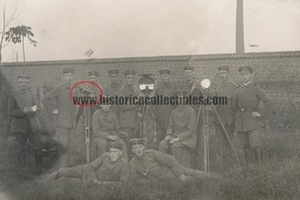Aussichtsfernrohr Telescope K.U.K. 28x Goerz Vienna N° 1, 1908
Aussichtsfernrohr monocular telescope produced by C.P. Goerz Wien. On the eyepiece plate there are the date and military acceptance stamps, which consist of the double-headed eagle accompanied by the letters "Ü.K." which place the telescope for exclusive military use. Furthermore, there is the "C.P.Goerz Wien" logo followed by the serial number which appears to be "N° 1" or the first example of this model produced. To identify the type of telescope there is the words “Aussichtsfernrohr modell Goerz 28x” (large-range telescope with optics with 28 magnifications). The object has a sun visor extension with a flap to protect the lens. The view is perfectly clear and the focus is smooth and perfectly adjustable.
The telescope is complete with its original leather case and the original tripod equipped with transport straps. In my opinion, the latter makes it clear how the use of the object was for the exclusive use of a few officers intended solely for the purpose of observation given the absence of the reticle. This telescope represents a real rarity in the optical sector, as to date there is no example with the same characteristics.
History of Goerz:
The C.P. Goerzer was a company of optical and photographic instruments founded in Berlin in 1886 by Carl Paul Goerz (1854-1923), together with Carl Moser, an optical researcher, and Ottomar Anschutz, a laboratory technician who were close friends; precisely from this last C.P. In 1889, Goerz had purchased the patent for the construction of the first shutter shutter for cameras capable of shutter speeds of 1/1000 of a second.
The company specialized in the production of lenses, cameras, telescopes and binoculars, including for military use. In 1886 it had around 25 employees, which rose to 2,500 in 1911, although at its maximum expansion the workforce reached 10,000 employees.
In terms of size it was not second even to Zeiss (which in the same period had 1000 fewer workers), and it exported to many countries, including Russia and the United States. In 1905, Goerz American Optical continued to operate independently in the United States until 1972. In 1908, Goerz Photochemisches Werk GmbH was founded in Berlin, this section of the Goerz group produced film for photography and cinema.
Goerz had a fundamental relationship with the armies of the time and military supplies. In fact, it remained famous both for the large trench binoculars (First World War) and for the binoculars supplied to all the weapons of the Austrian-German Army (including navy and air force) as well as Bulgaria, Romania etc. Even today there are countless examples of Goerz binoculars that have value on the war and optical antiques market; it must be considered that in 1906 Goerz had already produced and exceeded 100,000 "Trieder" model binoculars, both for civil and military use.
In addition to the main and historic factory in Friedenau (Berlin), C.P. Goerz was also present in London, Paris and Vienna, Bratislava, Milan, Riga and St. Petersburg. Other sections were dedicated to chemical products and also to typewriters or calculating machines, which a division of the company was responsible for producing until 1945.
In 1910 the company bought the "Sendlinger Optische Galswerke" company founded by J.Von Fraunhofer eC. A. Steinheil for the production of optical glass and mirrors, which made it completely independent from purchasing from other retailers. After the First World War, with the Treaty of Versailles, the German companies that had produced war material were slowed down in production and this quickly led to a serious economic situation.
In 1923 Paul Goerz died and the company, in bankruptcy, was purchased by Zeissche, together with the companies "Contessa", "Nettel", "ICA" and "Ernemann" and founded Zeiss Ikon in 1926. The American division of Goertz became an independent company under the name Goertz American Optical Co., producing camera lenses and continuing their technical development. In 1971 it was bought by Kollmorgen, which was absorbed by Schneider Optics in 1972.

